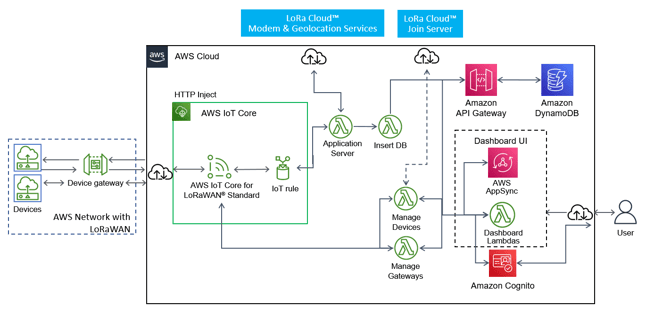LoRa Cloud™ offers component services that work in conjunction with LoRa Edge™ enabled chipsets to give customers the opportunity to benefit from Semtech’s chip-to-cloud solution for low-power geolocation.
By partitioning the workload between the device and the Cloud, customers benefit from long battery life, which unlocks new use cases for asset tracking that were previously not possible.
The services required to build a complete asset tracking application are minimal. Typically, these include a LoRaWAN® network server, a payload decoder, and something to call LoRa Cloud APIs, database, mapping, and application logic.
LoRa Cloud services need to be combined with other Cloud services to build a complete asset tracking application.
Although customers can piece together these building blocks themselves using different services and components, Amazon Web Services IoT Core for LoRaWAN offers customers many of the essential components all in one place. This collection of components can help customers succeed in building their applications. To make it easier for customers to integrate LoRa Cloud with AWS IoT Core for LoRaWAN, Semtech has provided open-source sample code via GitHub.
The following diagram shows an example of integrating AWS IoT Core for LoRaWAN using its serverless functionality. First a diagram of an example integration:

Sample integration of AWS IoT Core for LoRaWAN
The sample application outlined above has three main functions:
- Provisioning tracking devices and gateways
- Processing tracker device data into location solutions
- Displaying location data to the user
The sample code provided in GitHub addresses the processing of tracker device data. For more information on provisioning devices, see the AWS IoT Core documentation for device onboarding. For information about adding gateways, see the documentation on AWS IoT Core documentation for gateway onboarding. For more information on displaying data on a map using AWS, please see the Amazon Location Service.
As provided in the sample Lambda code on GitHub, tracking devices are provisioned on the AWS IoT Core for LoRaWAN network and report their data through the attached gateway(s). An IoT rule is set up to pass data for the tracking devices to a Lambda function called Application Server, which parses the message and determines whether it needs to be processed by the Semtech LoRa Cloud Modem & Geolocation Services. Messages that are processed by the Semtech LoRa Cloud Modem & Geolocation Services and that return a location estimate are sent through an API gateway to the main storage functionality in the Amazon DynamoDB. That same API gateway is then used to access and plot the location data on a dashboard, showing the status of the tracking device.
This simple example shows how various AWS serverless tools can be used together to provide an end-to-end tracking system with LoRa Edge enabled devices.
Semtech®, the Semtech logo, LoRa®, and LoRaWAN® are registered trademarks or service marks, and LoRa Edge™ and LoRa Cloud™ are trademarks or service marks of Semtech Corporation or its affiliates. Other product or service names mentioned herein may be the trademarks of their respective owners.